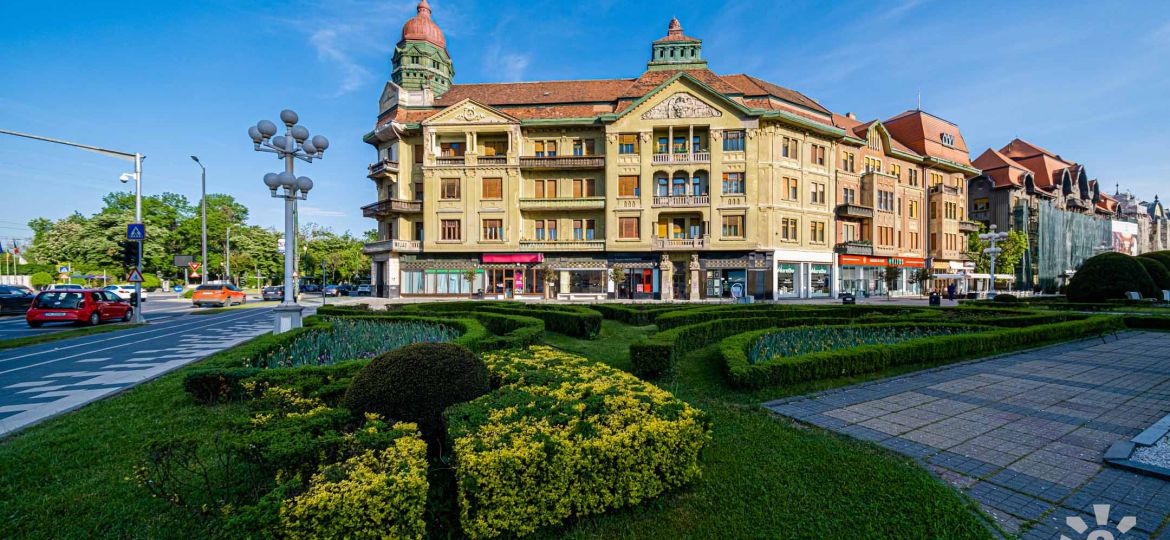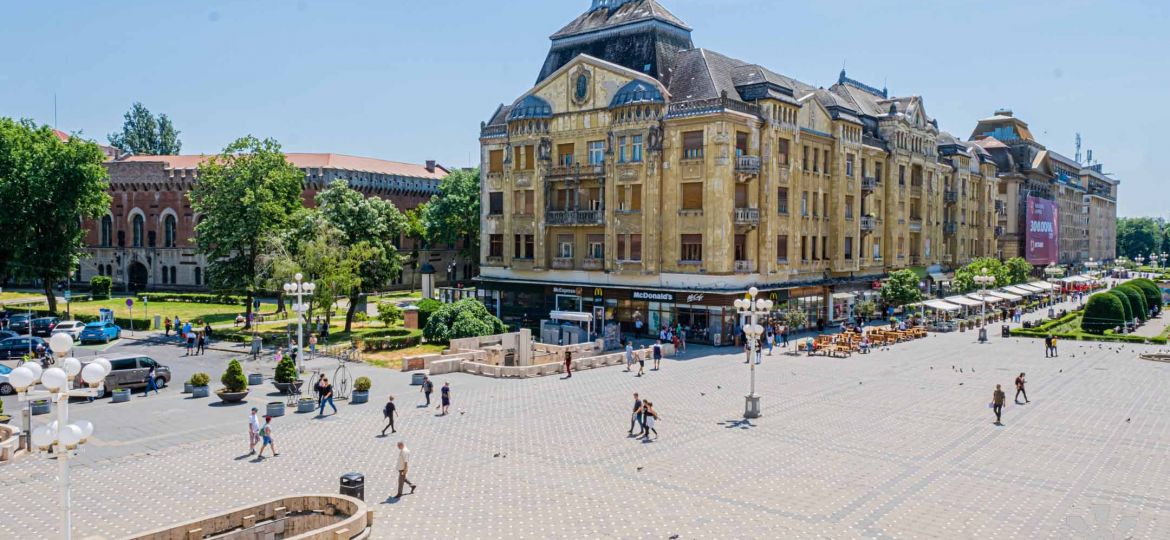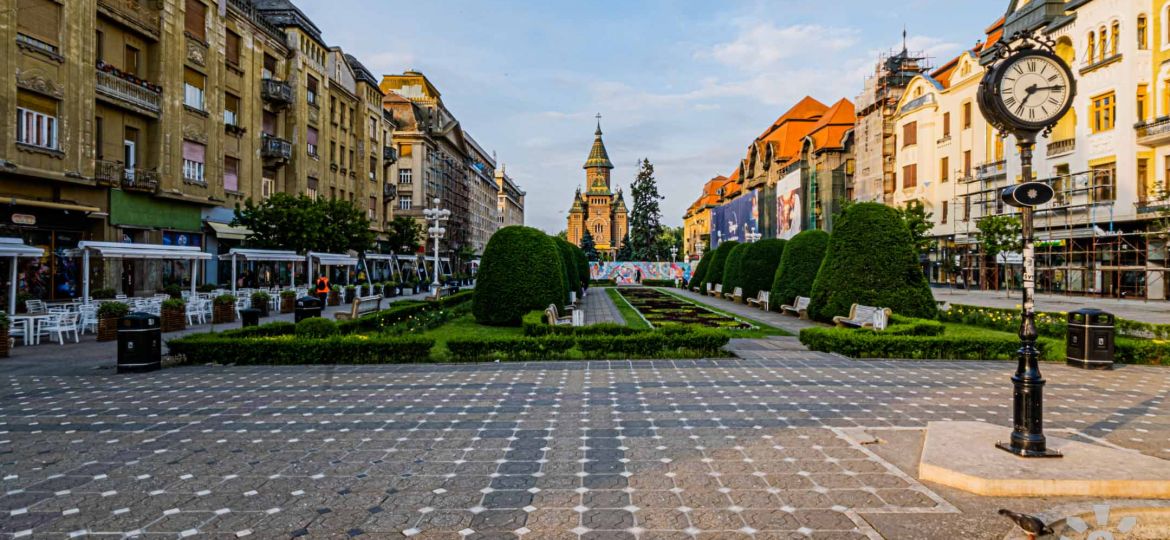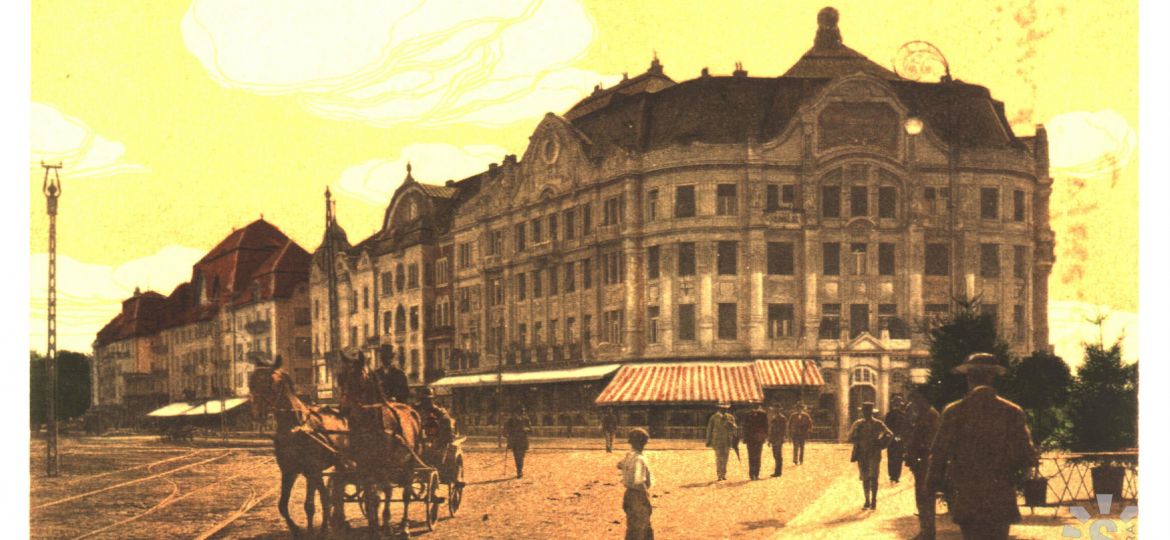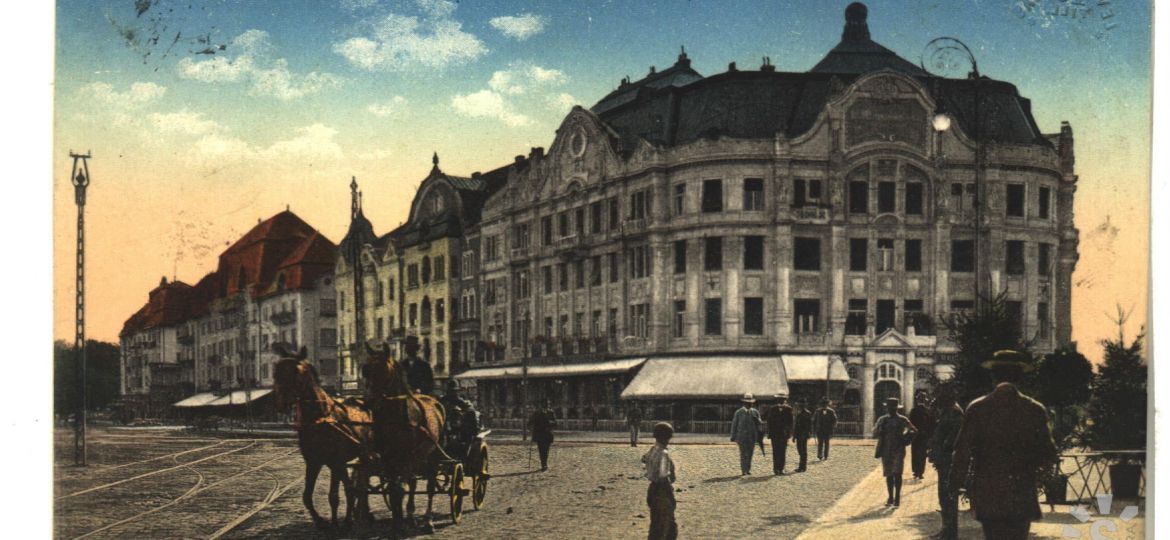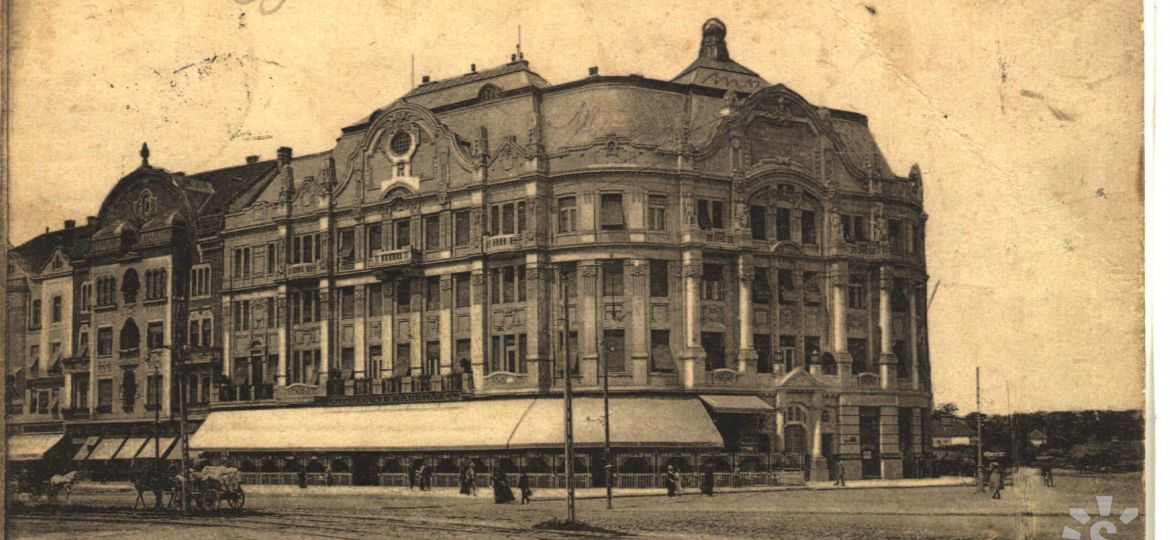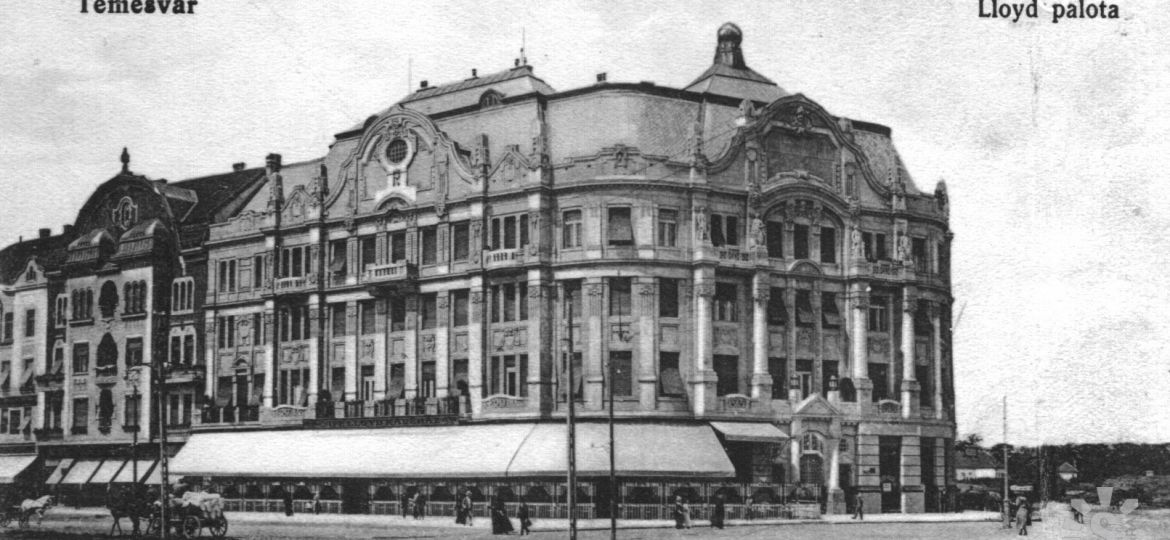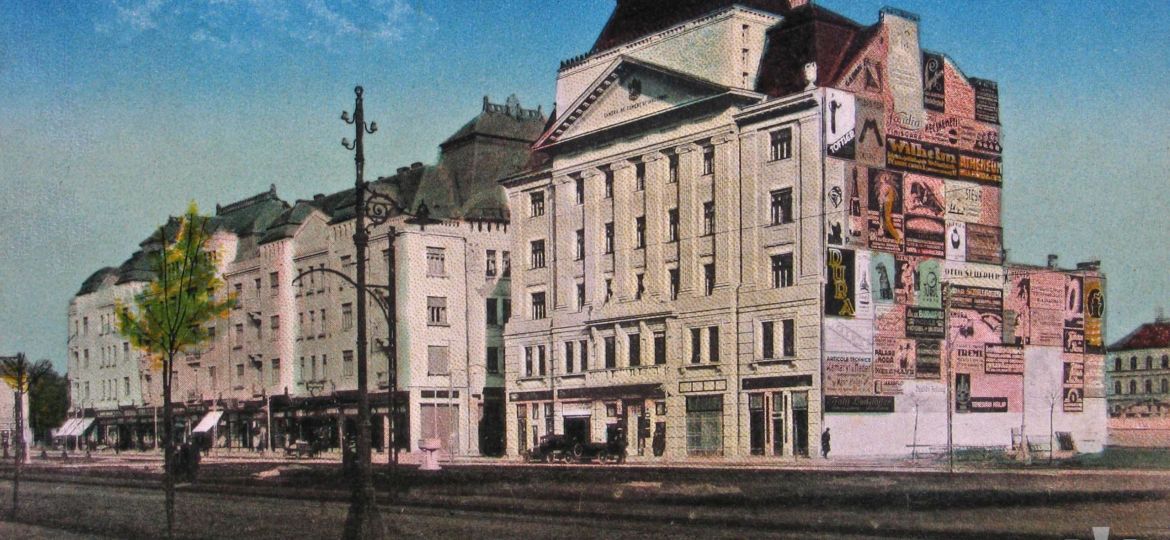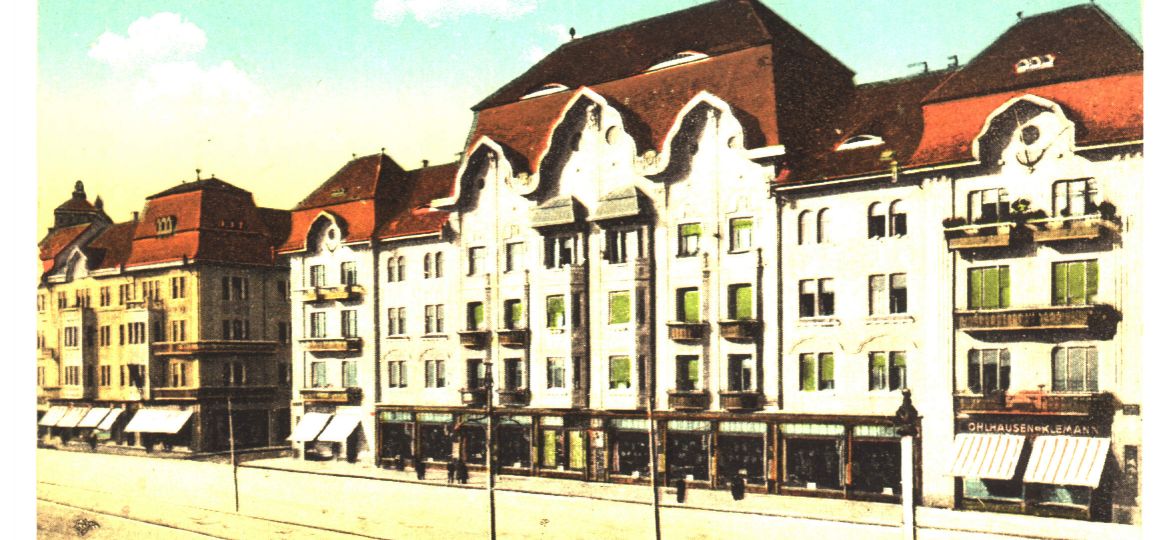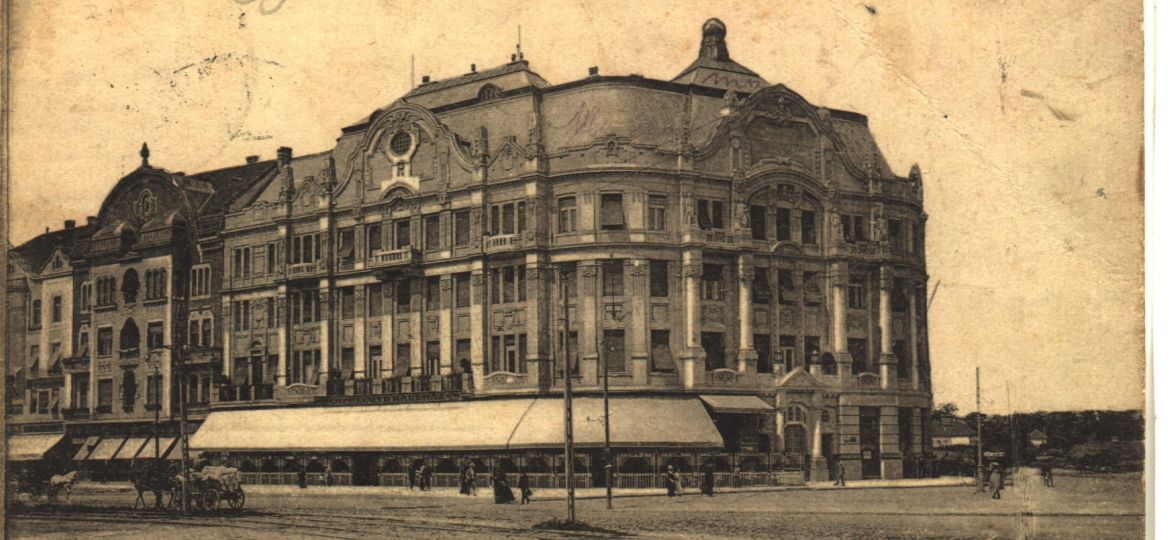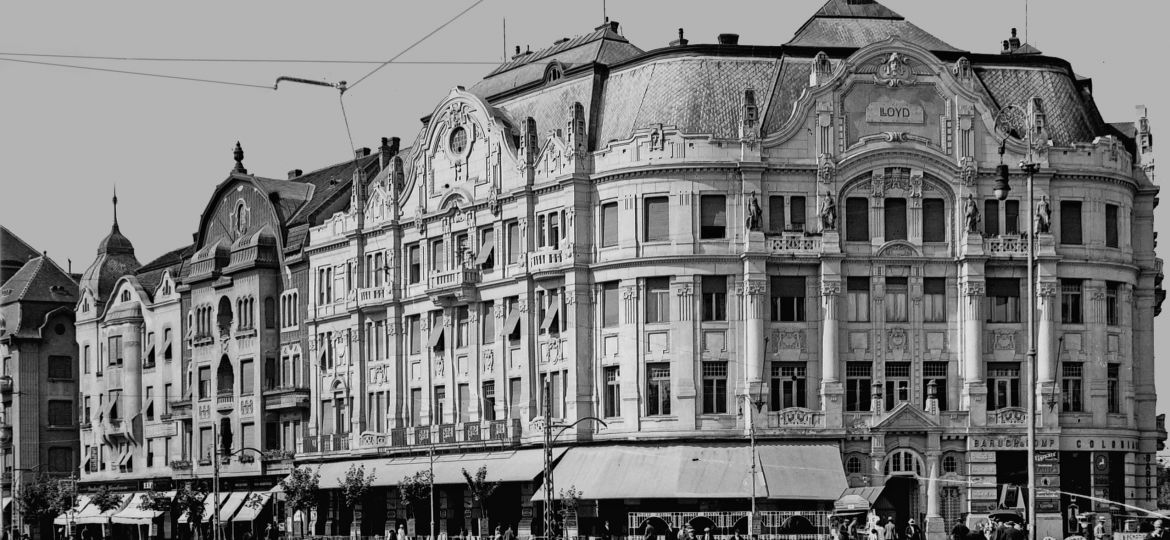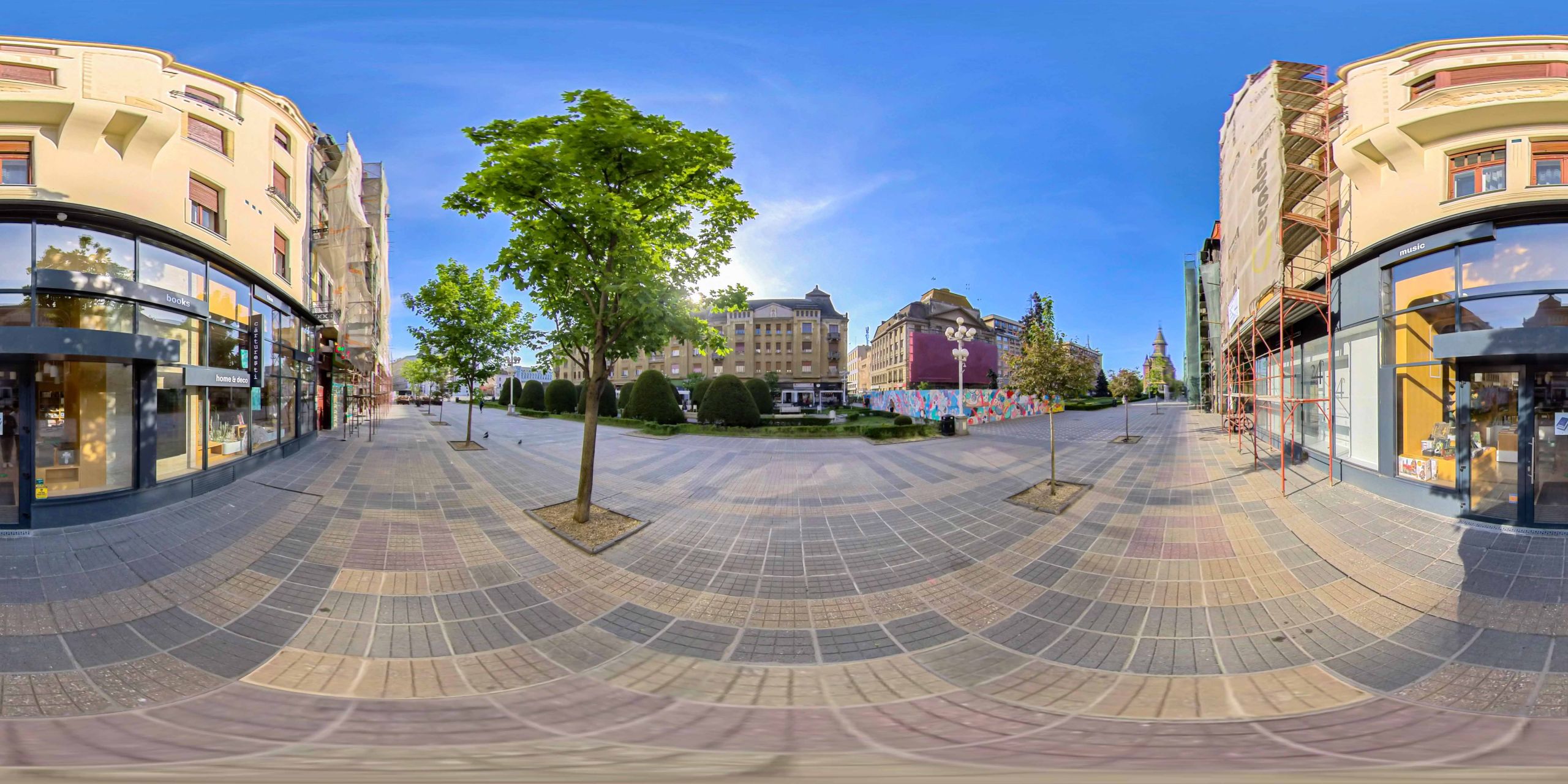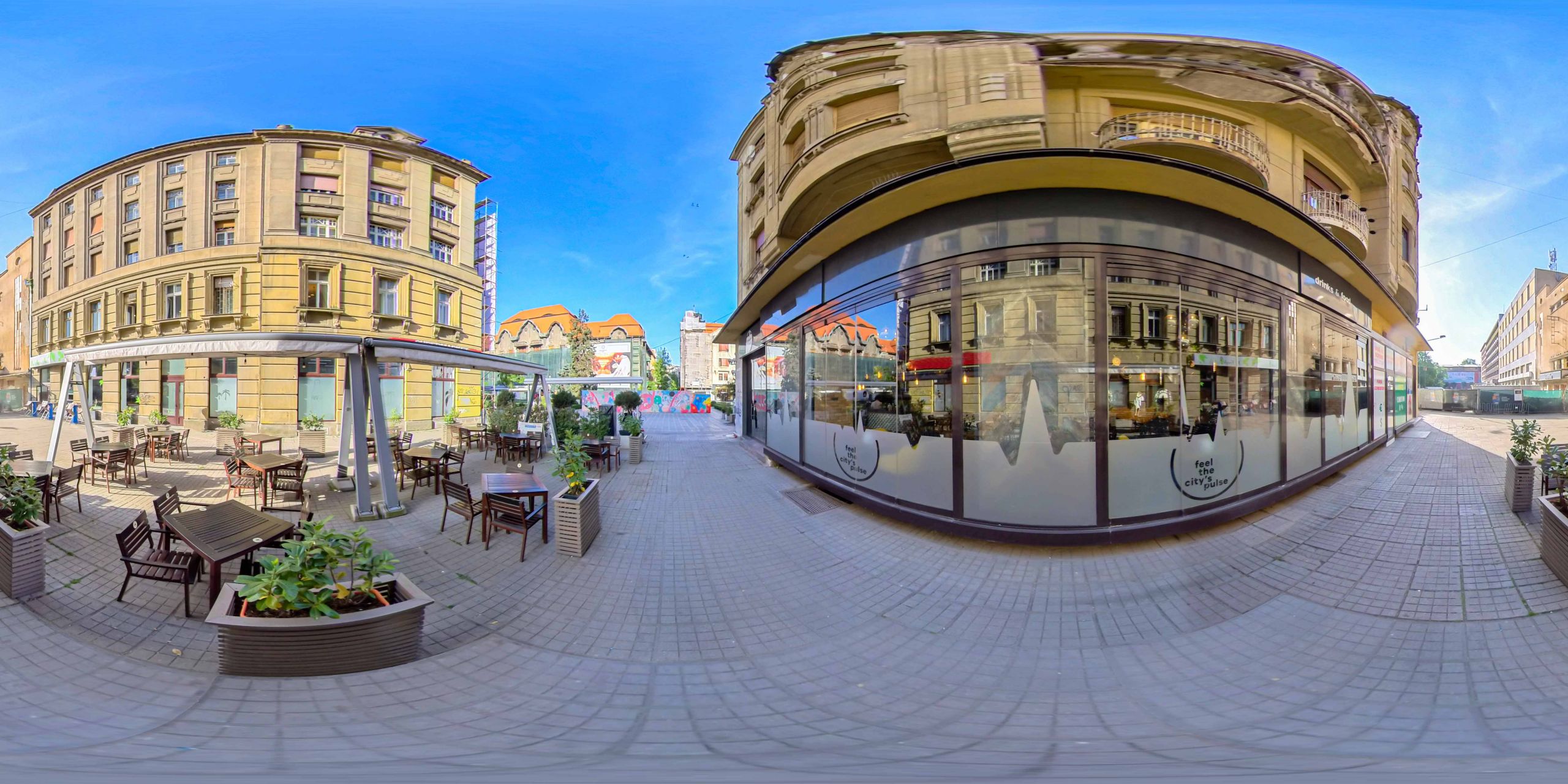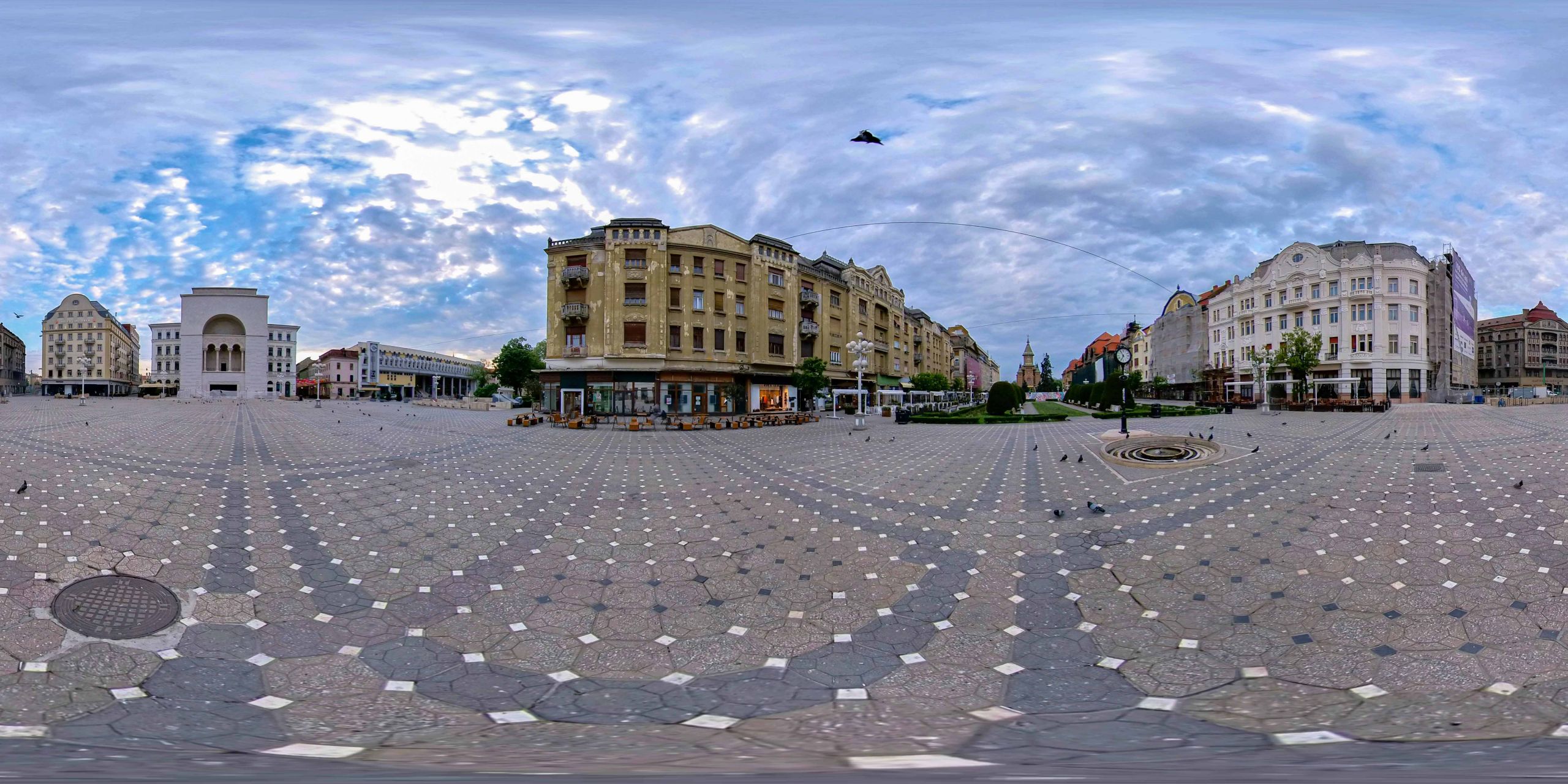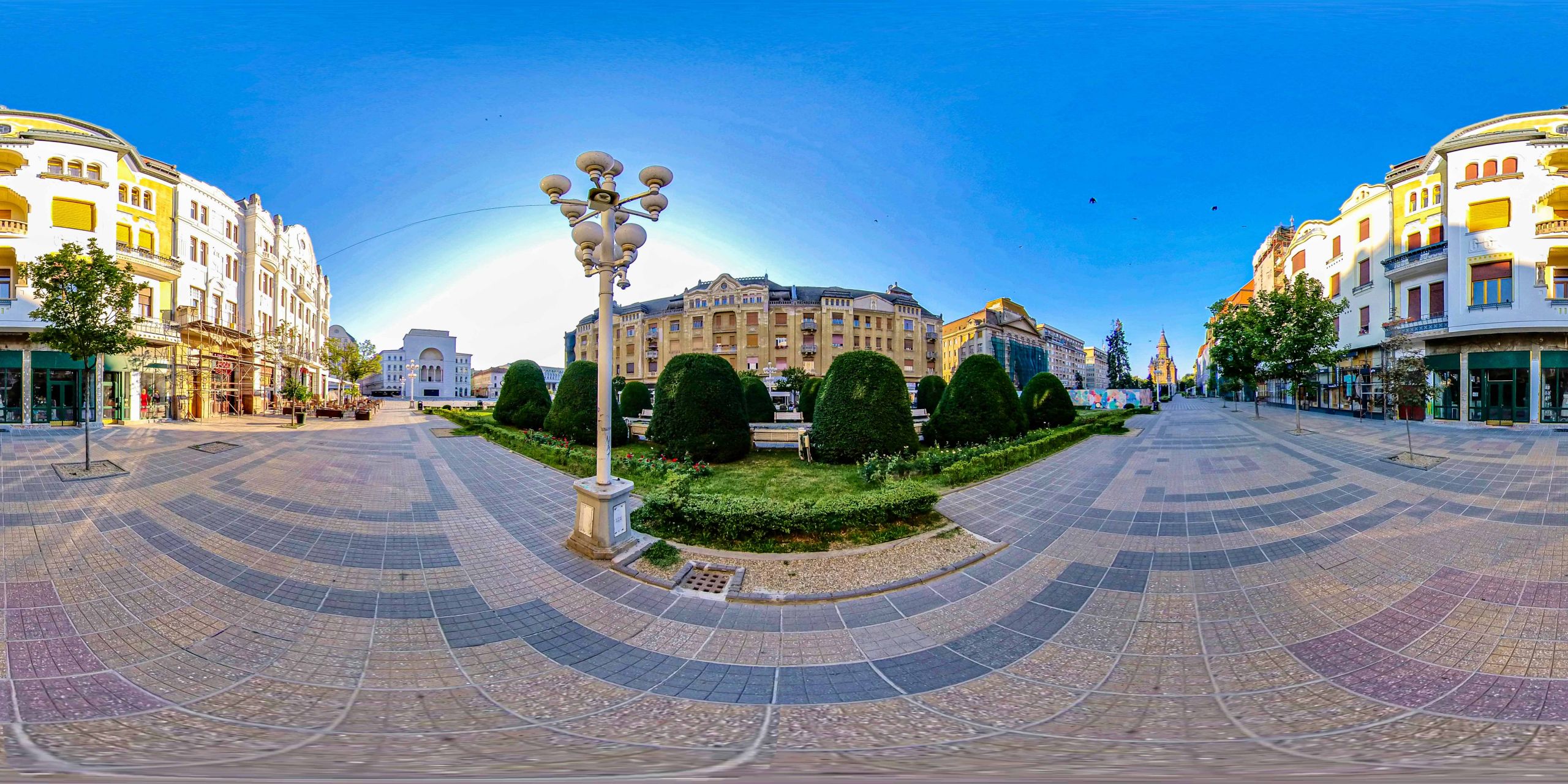The row of palaces in Victory Square was built in the extra-muros area of the Cetate neighborhood, which is located on the former Esplanade, the 948-meter-wide plain around the fortress, on which it was forbidden to build.
Listen to the audio version.
The row of palaces in Victoriei Square was built in the extra-walled area of the Cetate neighborhood, which is located on the former Esplanade, the 948-meter-wide plain around the fortress, on which it was forbidden to build. In 1868 the esplanade around the fortress was reduced from 948 meters to 569 meters.
In 1892, the character of a military fortress of the fortress was annulled and the demolition of the fortifications began (after 1899). The General Plan for the Development of the City from 1893-1895, drawn up by the architect Lajos Ybl and the engineer Aladar Kovács Sebestyén, provided for the construction of a boulevard the size of the current market.
The western pediment of Victoriei Square is furnished with monumental buildings between the Opera and the Romanian Orthodox Metropolitan Cathedral. This pediment includes the palaces: the palace of the Weisz company (architect Adalbert Szladek, sponsored by Dr. Frigyes Hajdu, building connected to the sewerage on October 19, 1926 and to the water network on November 4, 1926), Lloyd's palace (headquarters of the Polytechnic University, Victoria Square no. 2, architect Lipót Baumhorn, builder Arnold Merbl, building permit of 29 August 1910, building opening on 29 September 1912), Ernö Neuhausz Palace (architect László Székely, building permit 26 October 1910), Arnold Merbl Palace (architect and builder Arnold Merbl, building permit March 8, 1911), György Dauerbach Palace (Dr. N. Paulescu Street no.1 - J.W. Goethe Street no.2, architect László Székely, building permit July 12, 1911), Lajos Hilt Palace (Square Victory Square No. 6, architect László Székely, building permit December 2, 1911, work completed in year 1913) and Széchenyi Palace (Victory Square no. 8, sponsored by Antal Vogel, architect László Székely, building permit 26 October 1911, work completed in 1913).
The eastern pediment includes the Jakab Löffler Palace (Victoriei Square no. 1, architect Henrik Telkes, building permit March 18, 1912, work completed May 1, 1913) and the Palace of Commerce and Industry (Victoriei Square no. 3, architect László Székely, building connected to the water supply on March 13, 1925 and to the sewerage on November 27, 1925), along with blocks of flats built between 1961-1963.
The built fronts of the buildings on the western side of the square belong to the style of the 1900s (Secession).
From the Opera to the Cathedral the promenade on the right is called Corso, and the one on the left is called Surrogate.
The two ends of the perspective, the Municipal Theater and the Metropolitan Cathedral, close compositionally, on the north and south sides, Victoriei Square and its promenade area, generating a refined and balanced urban space.
The Lupoaica sculpture with the twins Romulus and Remus, located on a 5 meter high pillar, is a replica of the work Lupa Capitolina offered to Timișoara by the city of Rome in 1926. The fish fountain was built after the Second World War, in 1957.
Bibliography:
- Mihai Opriș, Mihai Botescu - Historical Architecture in Timișoara, Tempus Publishing House, Timișoara, 2014
The row of palaces in Victory Square
The 3D Crucifixion Monument
Listen to the audio version.
Robert Șerban
pigeons eat the plaster
cries a white-haired gentleman
pointing his cane at the scarred palace
we both turn our heads at once
all we see are empty swallow nests
up
under the eaves
and an open window
through which stick out like a tongue
the drapes
the old man stomps his foot in anger
loses balance and falls
we take flight
every which way
June 2022
“Timişoara, with its crowded ‘Corso’... […]
Timişoara with its wide, clean, well-paved, bright and endless boulevards, occasionally lined with prestigious businesses and large, sometimes stylishly adorned display windows... Timişoara with its shops ‘zarva’ after six o’clock in the evening, with fine, polished, often uncomfortable or crowded trams, with the patched looks of a fashionable city – imagine, in the heart of Banat, a map drawn by a geographer with lapses of memory... […]
The factory chimneys with their elegant silhouettes, from which today hardly comes out a tiny thread of smoke, which mocks ... life ... they say, once intense ... the bridges that connect the five small cities ... ‘Lloyd’ , ‘Palace’, ‘Loffler’, ‘Ferdinand’, and a courthouse set in four streets, with over 200 rooms and 13 corridors... Mild climate […].Lloyd", "Palace", "Loffler", "Ferdinand" and a courthouse stuck in four blocks, with over 200 rooms and 13 corridors... Indulgent climate [...].
An exotic Timişoara for travelers from other parts of the country, whom the city with the appearance of a ‘work’ of an engineer strikes at once.
Urban street life…” (Camil Petrescu, Three Springs, Timișoara, Facla Publishing House, 1975, p. 148-149)
(…) Later, when I grew up, there was a very good bookstore, the "Niculescu" bookstore, on the opposite side of today's "Eminescu" bookstore (replaced today by the Cărturești Bookstore n.n.) on the ground floor of the Löffler Palace, close to the CEC agency, from McDonalds to the Cathedral.
(…) Then there were the Meinl stores, a network throughout the country, branches of a German company, where it always smelled terribly good like coffee. There was one on Corso, where the "Helios" gallery and the gelateria next to it are now.
Radu Ciobanu (born 1935), interviewed by Simona Adam in 2002 in Deva. Third Europe Archive, BCUT.
Listen to the audio version.
Two people from different corners of the world "found in" Timisoara.
With fear of the new, deep emotions, anxiety and shyness, this is how the first year of college was to begin for us. We knew from the start that we were more different, it would have been hard for us to fit in if we hadn't found the courage to talk to each other. But, Victoria Square would bring us closer, that's where our friendship would bind. We were in the first semester of our first year at university, a project we had to do for an exam made us get to know each other and, at the same time, to "get lost" in Timișoara. It was a project in which we had to make a video promoting Timisoara. Since neither of us knew the city, we decided to go and film different shots of the city. Victoria Square, but also from other nearby areas we discovered that day. The first shot I filmed was to feature the Cathedral and the pigeons flying in tandem. Our attention was drawn to the aisle of coloured umbrellas, which led us to the Liberty Square.
After managing to get enough material for our project, we chose to stop by Symphony Cafe, where we were going to discuss how we were going to mount the frames we made. Naturally the discussion degenerated and we completely forgot about the project, and Symphony Cafe became the place where Friday nights and Saturday mornings began. In Victoria Square we'd have to meet every time to have coffee before class. That's where our friendship was cemented one spring.
Elena R & Christine G, UPT Student, 2023
Little explorers of Timișoara
by Camelia-Diana Șomai, 7th grade
"Grigore Moisil" Theoretical High School Timișoara
It was a fantastically sunny day. The sky was a crystal blue, the sun a star, and the clouds white, like cotton candy. It was particularly warm and pleasant at the same time. Perfect weather for the start of new adventures. We were flying agally with the spring wind blowing in my face, enjoying the gentle rays of the sun. On our faithful pigeons, we watched over the world below. A sea of houses, rooftops, separated by winding, winding streets, with a multitude of cars, engines, trams and buses whizzing back and forth.
On the outskirts of the city, rolling hills and bright green fields. The view was fantastic, like something out of a fairy tale, but a bit noisy for my taste.
- Aaa! Let me introduce myself, I guess you don't know me! I'm Ziva! The little guy next to me is Niyol, my impudent brother! We're two tiny little men on pigeons. We come from far, far away on a mission to find and study humans.
This was our first mission, and now we were flying lightly to the city we were supposed to visit.
Everything was milk and honey until the wind started to pick up. We flew fine for a few meters, then the doves started to slow down. The wind didn't let up and it was blowing harder and harder and harder. For tiny little people, not even four inches, the size of matchsticks, it felt like a real storm had started, not just a gust of wind.
Not long after, the wind blew Niyol off the pigeon. I held on even tighter to my pigeon, but the wind continued and I too flew off to the 'underworld'. We began to shout, watching as we plummeted into the void and came closer and closer to the sea of houses below us.
Armed with everything we needed for an adventure, we kept our composure and, taking our hands to our backpacks and then pulling, we opened our parachutes. We were thrown up, but regained our balance and floated gently to the ground.
Niyol, who was still descending into the void before me, just barely missed the statue of a she-wolf. Below it were two human cubs, all three of them perched on a stone slab, perched on a column about fifteen meters high, maybe more. Try as he might, my brother slipped right past it, landing at the foot of the plinth.
I, a little heavier than him, settled my landing better and landed on the head of the she-wolf. I looked down and my heart was as big as a flea seeing my brother. The wind was still whipping and it wanted to throw me off the she-wolf. I grabbed hold of her neck and held on, and then, more or less desperate, I bravely ran after my brother.
I saw Niyol stand up in a daze and get lost among the flowers. I landed and started looking for him. After we found each other, we looked around. We were in a huge and very crowded square. We walked out of the floral space and onto some stone slabs. In front of us was a beautiful and very sophisticated building with spires. I took out my map and looked at it.
The cathedral in front of us looked exactly like the one on the map. Now we knew where we were. We were in Victoriei Square, in the center of Timișoara! The good part: we arrived at our destination. The bad part ... remains to be seen!
We set off screaming and heart pounding ready to burst our chests. We had to find our pigeons. We walked on, trying not to be run over by people, crushed by the wheels of our bicycles, and not to get lost. We came now, with difficulty, in front of another sem semean building. It had been behind us when we were looking at the cathedral and now it was right in front of us, white as milk foam, the marvelous Opera House.
Beautiful scenery, beautiful experience, but now we didn't take any of that into account. We just wanted to find our pigeons. Our bad luck was, we saw dozens, if not hundreds of pigeons landing. Niyol almost burst into tears and kept telling me that we had gone from lake to well and that it was going to get worse.
I peered into the ocean of feathers and heads. Nothing. You know, a real flier knows his bird very well! But I saw, not far from us, a table, from the center of which rose a strange metal pole, which was broken by a circle of cloth, fringed at the ends with lace. I made a dash for the table, to climb on it, then to scale the pole and reach the top to get a better view. We were eager to find our pigeons and then continue our exploratory mission.
There were no people at the table, so we managed to scramble our way up the chairs and then jump up and onto the table. It was a large table that could be occupied by several people and there were several umbrellas. There were many plates, cups and glasses on the table. Niyol started to investigate everything and climbed onto the rim of a mug, but inadvertently tripped and fell into it. He came out full of creamy-brown splashes and white cream in his hair. The aroma of coffee, milk and vanilla, a sign he'd landed in a cappuccino. I almost rolled on the floor laughing, though he didn't think it was funny. We started to climb the pole we'd spotted earlier, clambering up a thick wire that could support us. Niyol first and me next, so that I could push him in case he slipped and fell. I didn't have any protection, and I didn't want to land in anything myself, as Niyol had also become extremely sticky.
We reached the top of an umbrella. From there, I watched the square full of birds.
- There they are!" shouted Niyol pointing to the two pigeons with saddle on their backs.
They were of course in the worst possible place. On a clock, perched on a black pole, right in front of a small fountain. Other pigeons were bathing in the well, just like at home.
Suddenly, just when we really thought we could catch our breath, the umbrella began to tighten, gradually shrinking, but, for us, quite quickly.
My legs got ahead of me.
- Ziva! Niyol shouted, grabbing my hand. The umbrella tightened and we both collapsed on a stool.
Nothing was broken and we escaped unharmed this time. But we didn't have time to fully sober up from the shock, as a man pulled the chair out and wanted to sit on top of us. We let out another scream and jumped down. And now I was on something soft. I rolled over and buried myself in a silky brown fur. Niyol pulled me out and then I realized I was on the back of a cat! It woke up, shook itself and threw us down. She then looked at us, how piqued we were with her eyes in which it was as if jalapeno was burning. She got up and began licking her nose with relish. Her head wrinkled and she began to move toward us. I swallowed dryly, then turned on my heels and swatted her. Niyol and Niyol and I ran tearing the ground behind us. The cat, with fur the color of a mane and a tail the size of a broom, was coming after us! We ran to the middle of the square, then we got tired. We stopped for a moment, but the cat came back, chasing all the pigeons away. I looked at ours, which thankfully stayed put.
The cat pawed after us. We started running again. I looked at the pole and had an idea. I pulled the cat towards me and left Niyol behind.
I changed direction, running harder than ever, and when I was only two or three centimeters from the pole I jumped on it, turned to face the sky and did a somersault. The cat didn't see the pole and at high speed, he didn't brake. He hit his head on the pole and fell into the well. I laughed and walked away.
Upon impact our pigeons took flight and landed low, three feet away from us. Niyol and I couldn't keep our skins on. In two shakes and three movements, we reached the pigeons, jumped on them, pulled the harness and soared into the sky. The cat emerged from the fountain and now watched us snarling and hissing from the middle of the square.
When we arrived back among the roofs and clouds, we breathed a sigh of relief, then we started to laugh.
- Now, let's go!
- Actually, let's fly! said Niyol, smiling.
We descended again, this time of our own volition, and flew over a long and rather wide river called the Bega. We were to explore that city, full of adventures and adventuresome adventures, for our little tiny people's work is never done, and the charm of this city cannot be deciphered in one or two steps.
I can't believe it. We're in Timisoara
by Daria Orbulescu, 10th grade
"Nikolaus Lenau" Theoretical High School in Timișoara
Having recently arrived in this city, I saw posters with the events of the month, but I didn't know on what occasion they were organized. People wore purses with the year 2023, the zero illustrated by a sun over the rest of the numbers. It was early, too early. I left the train station behind me, hopped in a taxi and made my way to the hotel where I was staying. It is in the center of the city, bearing its name. I didn't know what had happened to the city where I was born. I had not been there for more than 70 years. The two buildings I remembered were the train station and the opera house. I had spent a lot of time in them, being an opera and operetta lover, and my father was a train conductor, but they hadn't evolved much. The trains were old even when I was a child, but now they are more suitable for a museum, and the railway station, which was a spectacular beauty many years ago, stood covered with canvas, and I could not remember anything from my home town.
Who are you, Timisoara? What happened to the peace you had in the past? I don't even recognize you anymore. Your citizens no longer know the famous Pheonix song that bears your name, but the world has changed and with it the people have changed. I took a last glance around the city center, not noticing any of the streetcars that used to run on the Corso. People were sitting in the buildings, which I can't help noticing how beautifully renovated they are, quietly drinking their coffee, forgetting about traditions and culture. But I didn't want to comment. After all, it had been many years since I had been here. I waited for a streetcar. I wanted to go back to the station. It was modern and very free. It reminded me of the old days when people used to get on the trams to get to work and sit right on the stairs, how crowded they were. I sat next to a very elegant older lady waving a fan.
- Are you okay? she asks me with sweet eyes eager to help me.
Am I okay? I wanted to tell him no, that I've come a long way to get here, to this city, my hometown, and when I saw it so changed, I was sad. Do I feel good? What a question!
- Yes, I'm fine, I'm just a bit disappointed and I have to catch a train, I finally reply. The woman looked at me, looked me in the eyes and said:
- If you don't mind, what disappoints you and where are you traveling to?
- I'm not traveling anywhere but back home to Vienna. Look, I was born here in the Fabric district, right in the Stephania Palace. Before I leave, I would have liked to see what the building I grew up in looks like, but I don't have high hopes.
- Would you like to leave? Have you been here long?
I realized I hadn't told Mrs. Context, but we're in no mood to talk.
- No, I just got here a couple hours ago.
- Oh, but you haven't had a chance to visit much, so I say spend a little more time. Maybe even stay for the concert tonight, if you're interested.
- I don't want to visit anything else, I think I've seen enough and I'm not interested in new bands. The woman noticed my disinterest and left me alone for a while, but she didn't last long.
- You said your hopes are low, I'm sorry to interject, but why?
I had no other choice. If I don't tell him, he won't stop. I'm an emotional and nervous man. My nerves were already frayed, but I explained everything. The woman looked at me stunned and told me I had no right to insult the city. Maybe I haven't been here for a long time, but everything is changing, and Timisoara's change is a good one. It's not going to stay the same as it was 50 years ago. Those were her words. I couldn't contradict her, although I wanted to. I wanted very much to be able to say something to her, but I held back. She was right, but I didn't want to accept it.
She asked me to go to a movie with her. She wouldn't tell me what movie we were going to see, but I said yes anyway. I was ready to say, "I don't know why you're trying to meddle in my life, but I suggest you drop out, I'm not interested in any movie". Instead of saying that, I accepted the lady's invitation.
I got off the tram near Liberty Square. I walked with this lady through the Opera Square, reaching the Timis Cinema and not long after the screening started. It was a movie called "The Secret Map". A sort of guide to Timișoara, something to do with coffee. I had never seen such a movie before and the thing that impressed me the most was the fact that after the movie was over, people didn't get up to leave. I was the only one who stood up. I saw people's gazes turned towards me. The woman pulled me by my shabby shirt sleeve and said:
- It's not over yet. Be patient.
I sat down, and after a while a blushing, modern lady walked in, greeted by a thunderous applause. I realized the movie was followed by a talk. After the talk with the lady, I stood up, applauded, thanked the woman for the invitation and left the room.
- It's still there, she says. Who? I wanted to ask, but I didn't.
- It's still there, she says again, as if I hadn't heard her. Him. And she points to an unkempt, gaunt, unshaven, pale man sitting on a bench in front of the movie theater.
- I think he's following me. I told him to calm down, I'll go check it out. Even though he wouldn't let me go at first, I went anyway. I started walking around. Do you understand how I felt? I really wanted to leave just to get out of town, and now I had to do it to find out about this man.
As soon as I took my first steps, he got up from the bench. He was about 20 meters away from me, but it was impossible to get rid of the thought that I was being followed, but I still had to act normal. We went past Victory Square, down a street with umbrellas and then to the German Theater. I looked at the posters of the upcoming shows and walked around the Union Square. It was much nicer and neater than it had ever been. I felt the urge to have a coffee, but not because I was tired and needed the energy, but because I saw coffee as a different way to look at the day. There was a small coffee shop nearby, I ordered and the stranger was the next customer. I didn't want to look at him, make eye contact, because he might dare to talk to me. But why would he? Why is he coming after me? Maybe he's not actually chasing the woman on the streetcar, maybe he's chasing me, even though I haven't been to Timisoara since I was just a kid and I don't think anyone knows me anymore. I took my coffee and sat down on one of the benches in the square. My leg and hip hurt. After all, I'm old. I shouldn't even be traveling at this age, and spying on people under no circumstances. Quiet. Then I saw some legs beside me. I got a terrible dizziness. I was shaking with fear and I could hear my teeth chattering. I took another look and noticed they were very yellow and almost colorless.
- What do you want? I ask him. I couldn't stand seeing him standing there without saying anything.
- Son, I want to talk to you. He pulled something out of his pocket. It was his wallet. Brown, torn, old. He didn't want to change it, because it had probably brought him good luck in life. He pulled out a small photo, like the one on his ID, but it wasn't complete. It was torn. He handed it to me to look at it, then I remembered, and it was as if I saw my whole past flash before my eyes. From my pocket, I pulled out a wallet as old and shabby as the man in front of me. I called him a stranger, but not anymore. From the wallet I pulled out the rest of the photo. It was almost colorless. I joined the two pieces of parchment together to form a whole. It showed two young faces. I recognized them immediately. Then I realized who was the man I had thought unknown for so long. He was my childhood friend. The one I spent time with. We used to go to shows together, to the opera, to festivals and concerts, both of us big Phoenix fans. I remembered how beautiful my life was and how without this visit I would never have seen him again. I hugged him and felt a tear fall down my cheek. I pulled out of the hug. It was salty.
- You have the same habits, he says. You still swallow your tears. I laughed and hugged him again.
-How did you find out? I ask. He told me that he knew I was coming and the woman I went to the movies with was actually his wife. It was all some kind of plan, and he knows me, so he knew I was going to spy on him.
- Sorry you don't like the city, he says. But everything changes. So do we. See that? You didn't even recognize me. You know how it is: "They've all been exaggerated in their time. Years flew by and the world forgot them." I smiled. I knew my friend had gotten older and so had I, but he was the same man with the same words recited from Phoenix songs, the same sharp mind and the same kind soul. Suddenly I realized that Timisoara had undergone a tremendous change and that I should not underestimate it. I realized how beautiful the city is and how wonderful the passing years have made it. Smiling, I told my friend:
- I can't believe it. We're in Timisoara. In the city where we were born, in times gone by. Thank you for finding me and reminding me of those times I'll never forget. Thank you.
Timisoara is the city of my childhood, the city that will always remain in my heart, no matter what it looks like. All roads lead to Rome and someday back to Timișoara.
–






